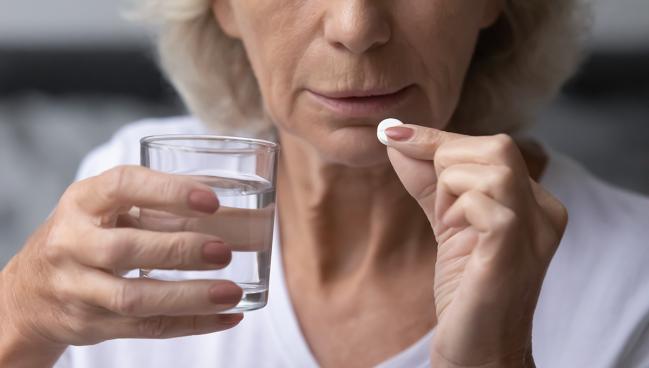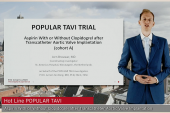More Support for Single Antiplatelet Therapy After TAVI
Clinicians see little benefit beyond monotherapy unless the patient has an indication for DAPT or oral anticoagulation.

CHICAGO, IL—Data from a new study provide yet more support for the use of single antiplatelet therapy (SAPT) after TAVI, with investigators concluding that dual antiplatelet therapy (DAPT) should be reserved only for those at highest risk of ischemic events or with an established coronary need for the drugs.
In a retrospective analysis of nearly 500 patients who underwent TAVI at a single center, there was a trend toward a lower incidence of death or ischemic events in patients treated with SAPT compared with DAPT. When investigators looked only at patients without CAD, the use of DAPT was associated with a significantly higher risk of death or ischemic events.
“Maybe we can start to stray from DAPT, but if you have to use DAPT, keep its use only in patients with severe CAD or those who have had a recent a PCI,” lead investigator Melissa Moey, MD (East Carolina University Health Medical Center, Greenville, NC), told TCTMD. “Single antiplatelet therapy appears to be best in patients that don’t have an indication for oral anticoagulation.”
The American College of Cardiology/American Heart Association guidelines for the management of valvular heart disease recommend low-dose aspirin monotherapy (class IIa) or DAPT for 3 to 6 months (class IIb) after TAVI in patients at low bleeding risk without an indication for chronic oral anticoagulation. However, as Moey noted, clinicians have begun to shift to SAPT following TAVI.
“Based on randomized data now from POPULAR-TAVI, most people have now gone onto aspirin monotherapy, typically, although some centers will use Plavix monotherapy,” Hasan Jilaihawi, MD (NYU Langone Health, NY), who wasn’t involved in the study, told TCTMD. “I don’t think there’s any additional benefit to dual antiplatelet therapy. Similarly, people have described anecdotes of prescribing oral anticoagulation, but now the weight of evidence is against routine anticoagulation.”
Some patients, such as those with complex CAD or those who’ve recently received a drug-eluting stent, will require DAPT, said Jilaihawi, “but that’s based on the coronary indication.”
Single Center, Retrospective
For the new study, researchers assessed the ischemic and bleeding outcomes associated with different antithrombotic regimens in a retrospective analysis of 492 patients (average age 79.7 years; 53.7% male) with symptomatic severe aortic stenosis who underwent TAVI between 2012 and 2020 at the East Carolina University Health Medical Center. Overall, 88.6% of patient were discharged on aspirin, 60.2% on a P2Y12 inhibitor, 10.8% on a vitamin K antagonist, and 12.2% on a non-vitamin K antagonist. In terms of antiplatelet therapy, 44.3% were discharged on SAPT and 52.2% on DAPT.
Compared with those taking SAPT, patients discharged on DAPT had a trend toward a higher risk of death, MI, ischemic stroke, or TIA at 1 year (12.4% vs 17.1%; IRR 1.60; 95% CI 0.97-2.68). There was no difference in the risk of major bleeding between the two antiplatelet regimens.
Next, the researchers performed a subgroup analysis in patients with and without CAD. In those with CAD, there was no difference in the risk of death or ischemic events at 1 year between TAVI patients who received SAPT or DAPT, nor was there any difference in the risk of bleeding. In the 310 patients without CAD, however, DAPT was associated with a more than twofold higher risk of death or ischemic events at 1 year compared with SAPT (9.2% vs 16.1%; IRR 2.24; 95% CI 1.10-4.77).
There was no difference in the risk of death or ischemic events at 1 year, or any difference in the risk of major bleeding, between those treated with oral anticoagulation and those who were not. In extended follow-up beyond 1 year, however, there was a higher incidence of late bleeding associated with oral anticoagulation: 23.0% with anticoagulation and 11.1% without it (IRR 1.87; 95% CI 1.10-3.11). The incidence of late bleeding in patients on anticoagulation was 10.2 per 100 patient-years versus 3.6 per 100 patient-years in those not on oral anticoagulation.
Maybe Watchman Instead of Long-term OAC?
Matti Adam, MD (University Hospital Cologne Heart Center, Germany), one of the discussants following the presentation, said their center transitioned to SAPT following POPULAR-TAVI. Prior to that trial, the ARTE study led by Josep Rodés-Cabau, MD, PhD (Quebec Heart & Lung Institute/Laval University, Canada), also provided support for SAPT. In that small study, SAPT reduced the risk of major or life-threatening bleeding but did not increase the risk of ischemic events compared with DAPT in TAVI-treated patients.
If a patient has recently undergone PCI, then a second antiplatelet agent is necessary, but he suggested the heart teams try to space out the two procedures by 6 to 12 months. The concern, said Adam, is “that you lose your patients to bleeding, and we really need to be careful with anticoagulation and antiplatelet therapy.”
Eberhard Grube, MD (University Hospital, Bonn, Germany), another of the discussants, agreed with use of SAPT following TAVI, noting that a new European consensus statement recommends monotherapy with low-dose aspirin after TAVI. “That’s what we’re doing,” he said, adding that physicians need to have a very good reason to put a patient on oral anticoagulation following TAVI, such as AF.
Given the higher risk of late bleeding, Moey said it might worth considering alternatives to long-term oral anticoagulation for stroke prevention, suggesting that left atrial appendage occlusion might be a consideration in patients with atrial fibrillation who undergo TAVI.
“There was also a trend toward lower ischemic outcomes and death with anticoagulation,” Moey told TCTMD. “So, it’s about trying to weigh the risks and benefits for those that need anticoagulation if it’s indicated. Maybe for those that need [long-term] oral anticoagulation, we could consider alternative therapies, such as Watchman.”
During the discussion following the presentation, Adam questioned how clinicians are managing patients who undergo valve-in-valve procedures. In these patients, the optimal antithrombotic regimen is far less certain, but noted they prescribe oral anticoagulation in these patients for 3 months.
Itsik Ben-Dor, MD (MedStar Washington Hospital Center, DC), who moderated the session, said they are not currently putting valve-in-valve patients on oral anticoagulation after the procedure. “But I don’t know if we’re doing the right thing,” he said, adding that there is wide variability among clinical centers.
Michael O’Riordan is the Managing Editor for TCTMD. He completed his undergraduate degrees at Queen’s University in Kingston, ON, and…
Read Full BioSources
Moey MYY, Nifong LW, Shah NN. Optimal antithrombotic regimen after transcatheter aortic valve replacement (TAVR): long-term follow-up study. Presented at: TVT 2022. June 9, 2022. Chicago, IL.
Disclosures
- Moey reports no conflicts of interest.





Comments